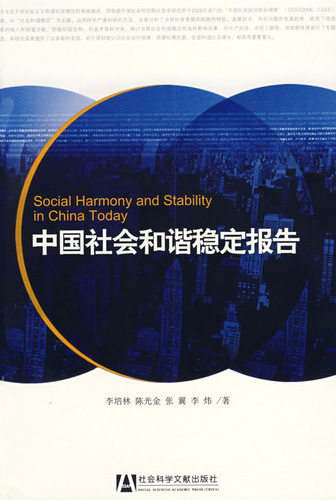
Brief Introduction
The book comprehensively analyzes the overall situation of Chinese social harmony and stability, and the impacting factors, which is based on the large-scale survey in 7061 sample in 2006; and introduces The distribution of the income and wealth, class structure changes, the status and political attitudes of the middle class, the existing state of peasant workers, poverty groups, as well as conflicts of interests. For policy makers and researchers, this book provides a detail and accurate data, and has an important theoretical and practical significance.
Catalog
Introduction the new building of a harmonious society is the great practice
I. The new stage, new features, new problems of Chinese development
II. The new progress of the theory about a harmonious socialist society
III. The system of the theory about a harmonious socialist society
IV. The Western theory of social construction
V. Building a harmonious society under the guidance of the scientific concept of development
VI. The ideas of accelerating social reform
Chapter I macro-background analysis, framework and methodology
I. A change in social structure: the macro-background
II. The basic framework of the social harmony and stability
III. Survey methodology and data
Chapter II the basic situation of current social development
I. The overall judgement of the social harmony and stability
II. The distribution of wealth and consumption gap
III. Pressure and social problems
IV. Fair sense, identity of classes and perception of conflicts
V. Supply of public goods and network of social support
VI. Challenges of integrating social value
Chapter III the impacting factors of the awareness ofsocial harmony and stability
I. Methods and variable
II. Analysis of impacting factors of the social harmony and stability awareness
III. Analysis of impacting factors of personality and family life awareness
IV. Analysis of impacting factors of sense of security, fairness and conflicts
V. Analysis of impacting factors of government’s evaluation
VI. Conclusions and discussion
Chapter IV the distribution of income and wealth
II. The income distribution, construction and gap
III. The distribution, construction and gap of family property
IV. The constrction of a gap between distribution of income and property
V. Conclusions, discussion and policy recommendations
Chapter V the change of social class structure
I. Several description of the current class structure in
II. The analysis paradigm of class structure
III. Measurement of Chinese current class structure
IV. Social attitudes of Chinese various social strata
V. Conclusions and discussion
Chapter VI the inequality of social stratification, human capital and income
I. Analysis of income inequality’s background
II. The distribution of income between diffirent classes
III. The proportion of the class income in total revenue
IV. The impact of human capital, class location on income distribution
V. Research conclusion and policy recommendations
Chapter VII the size, identity and social attitudes of the middle class
I. The concept of middle-class
II. The definition, measurement and scale of the middle class
III. The social recognition of middle-level and its formal factors
IV. The main factors of the middle class’ social attitudes
V. Conclusions and discussion
Chapter VIII the strength and political attitudes of the middle class
I. Is the middle class a "stabilizer" or machine of "change"
II. The new middle class and the elderly middle class
III. The political attitudes of the middle class
IV. The recognition of middle-level and its impact factors
V. Conclusions and discussion
Chapter IX the economic status and social attitudes of peasant workers
I. The economic status of peasant workers: income, working hours and social security
II. The social attitudes of peasant workers
III. Explain to peasant worker’s positive social attitudes
IV. Conclusions and discussion
Chapter X analysis of poverty groups
I. Problems and methods
II. The identification and scale of the poverty groups
III. The depth, strength and anti-poverty efforts of urban and rural poverty
IV. The features of urban and rural poor population and the impact factors
V. Conclusions and discussion
Chapter XI contradictions of interests and conflicts
I. The recognition of interests conflict and its impact factors
II. Multiple analysis of factors impacting the awareness of interests conflicts
III. The interests division and conflicts between social groups
IV. Case analysis of interest conflict between social groups
V. Conclusions and discussion
Closing remarks main findings and policy recommendations
I. The main findings and basic conclusion
II. The policy recommendations to promotion of social harmony
References
Appendix to the questionnaire
Postscript
